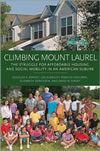News Updates
NJ’s Affordable Housing Crisis: How Did We Get Here? NJTV Talks to FSHD Founder
Published on September 5th, 2017 in Fair Share Housing Development
New Jersey is famous for having one of the highest costs of living of any state in the country. And as the state becomes less and less affordable, towns are being tasked with building hundreds of thousands of units for low-income residents. Many towns are fighting their given quotas. Many already in court. But while few would argue the state doesn’t need more affordable housing, the path to affordability is still unclear for those still Chasing the Dream. Correspondent Briana Vannozzi has this first of our three part series. TO WATCH THE VIDEO CLICK HERE OR READ THE TRANSCRIPT BELOW.
To understand New Jersey’s affordable housing situation, you need to go back roughly 40 years, when the sleepy Burlington County town of Mount Laurel became ground zero for the crisis.
Assistant Teaching Professor Alan Cander at the Bloustein School of Planning and Public Policy at Rutgers University explains how it all began.
“The township of Mount Laurel decided it would create a zoning ordinance in which they prohibited the construction of multiple family dwelling units, and apartments, trailer parks, anything we would call more affordable housing,” said Cander. “And the southern Burlington County NAACP sued the township and said look, you’re prohibiting people from living here by making it impossible for them to live here. And we are not only in the path of growth, but we are closer to where the jobs are.”
Out of it came the landmark Mount Laurel I decision. It declared New Jersey the first state in the nation barred from using land use zoning to exclude the poor.
But like many laws by judicial ruling, there was not a clear path forward for municipalities to follow. As a result, many towns did not abide by the new law.
“Then you have Mt. Laurel II in 1983 and that case was more about remedies,” said Cander. The question became, “How do you do this?”
More specifically, how does a judge determine whether a town is meeting its fair share?
Affordable housing is for residents with low to moderate income. In New Jersey, there are three categories: very low, for families making under 30 percent of the median income for the area; low, which is 30 to 50 percent; and moderate, between 50 and 80 percent of the median.
New Jersey is one of the highest cost of living states in the nation.
In 1985, the Legislature enacted the Fair Housing Act, which created the Council on Affordable Housing, the agency tasked with overseeing it all.
Housing advocate Arnold Cohen is senior policy coordinator with the Housing & Community Development Network of New Jersey.
“What happened was, we had a succession of governors who did not want to see this progress, and consequently we had a log jam,” said Cohen.
The Council, or COAH for short, was dysfunctional to say the least. It was unable to give towns a clear number for their housing obligation, and local governments did little to solve the issue on their own.
The requirement was working well during the 1990s, but then hit a 15-year period where there was little to no movement on affordable housing development.
Most of the council’s time was spent entangled in court challenges. Local government pushed back. Some cited worry about meeting needs for transportation, overflow in schools and decreased property values.
“Municipalities, they’re in the business of providing services. They’re in the business of competing with each other to be the best municipality to provide the best services, so they’re also looking for development that brings in tax ratables,” explained Cander. “Affordable housing does not bring in tax ratables. Affordable housing brings in the need for more services.”
Peter O’Connor with Fair Share Housing Development has been involved in Mount Laurel from the beginning. He was one of the attorneys who filed suit on behalf of plaintiffs and the NAACP in the original Mount Laurel case in 1971.
“This in my mind is a racial issue. It has been a racial issue from day one in Mount Laurel, and without the Supreme Court’s mandate to overcome that or at least put it at bay, Mount Laurel housing would never have happened,” said O’Connor.
In 2015, the state Supreme Court stepped in yet again, taking control from COAH and putting the decision-making back in the hands of trial judges. Municipal governments sued, leading to some 350 cases.
In January 2017, the courts ruled that towns would also have to make up for that 15-year gap period. Adding on to the number of units required from each municipality.
“That number should be probably in the neighborhood of a little over 200,000 units statewide,” according to O’Connor.
It probably comes as no surprise that number is being disputed.
Now, all eyes are on Mercer County, where the first in the latest round of lawsuits is playing out because a few towns there were unable to settle on their number. It will likely act as a road map for other cases across the state.



